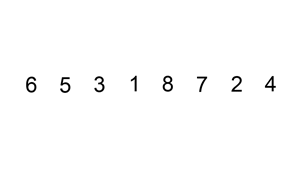forked from franklingu/leetcode-solutions
-
Notifications
You must be signed in to change notification settings - Fork 0
/
Solution.py
56 lines (44 loc) · 1.62 KB
/
Solution.py
1
2
3
4
5
6
7
8
9
10
11
12
13
14
15
16
17
18
19
20
21
22
23
24
25
26
27
28
29
30
31
32
33
34
35
36
37
38
39
40
41
42
43
44
45
46
47
48
49
50
51
52
53
54
55
56
"""
Sort a linked list using insertion sort.

A graphical example of insertion sort. The partial sorted list (black) initially contains only the first element in the list.
With each iteration one element (red) is removed from the input data and inserted in-place into the sorted list
Algorithm of Insertion Sort:
Insertion sort iterates, consuming one input element each repetition, and growing a sorted output list.
At each iteration, insertion sort removes one element from the input data, finds the location it belongs within the sorted list, and inserts it there.
It repeats until no input elements remain.
Example 1:
Input: 4->2->1->3
Output: 1->2->3->4
Example 2:
Input: -1->5->3->4->0
Output: -1->0->3->4->5
"""
# Definition for singly-linked list.
# class ListNode:
# def __init__(self, x):
# self.val = x
# self.next = None
class Solution:
def insertionSortList(self, head: ListNode) -> ListNode:
def insert(sl, node):
if sl is None:
return node
prev, curr = None, sl
while curr is not None and curr.val < node.val:
prev = curr
curr = curr.next
if prev is None:
node.next = sl
return node
prev.next = node
node.next = curr
return sl
sl = None
curr = head
while curr is not None:
nn = curr.next
curr.next = None
sl = insert(sl, curr)
curr = nn
return sl